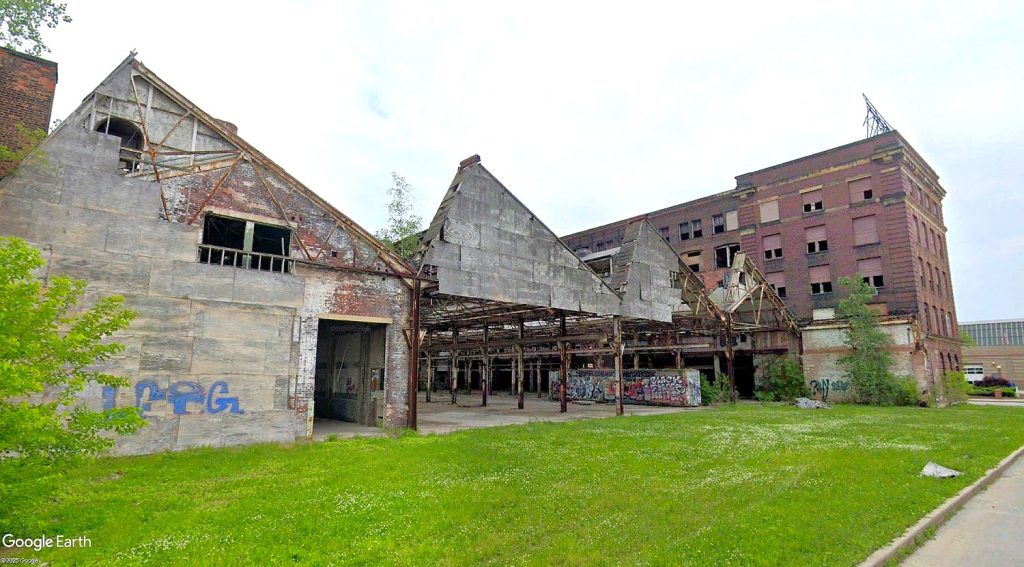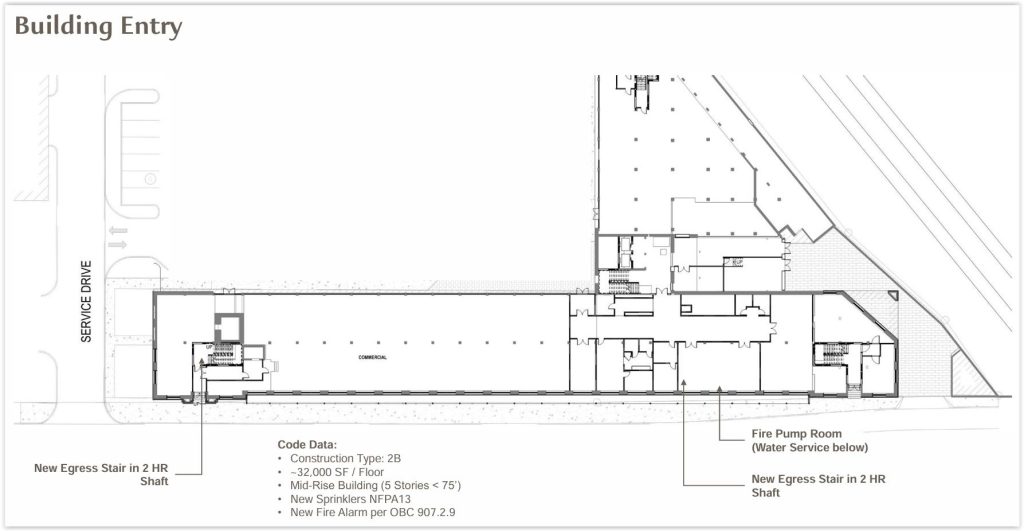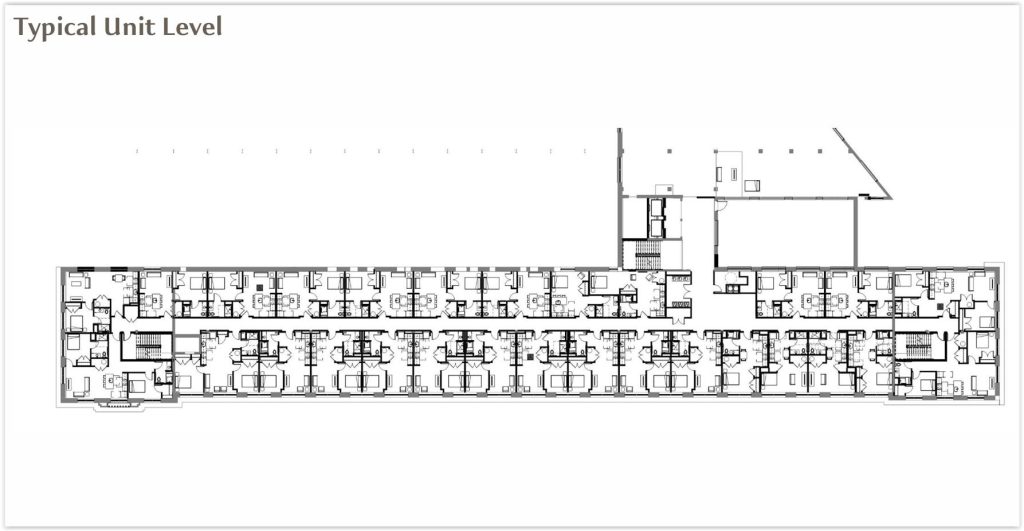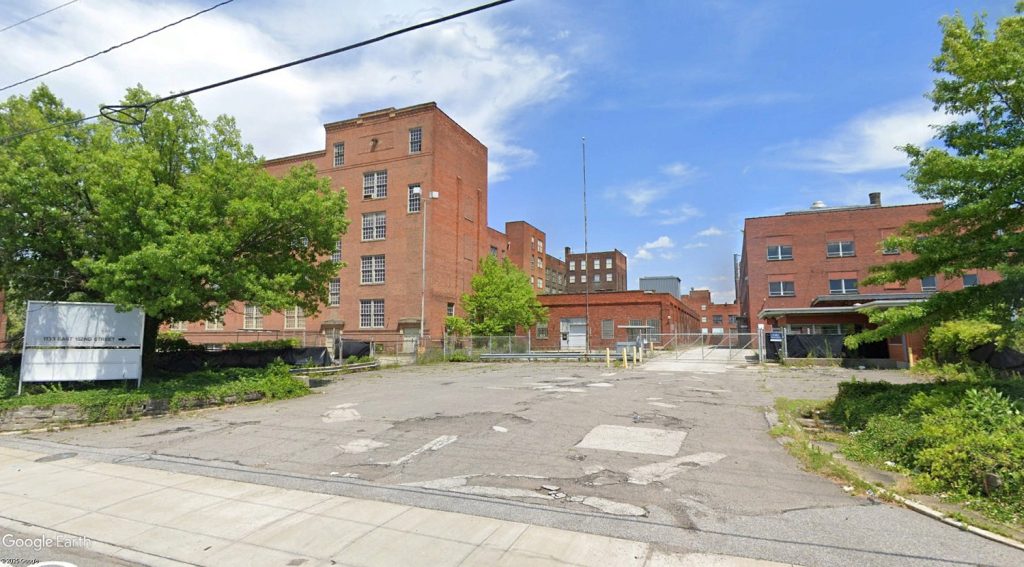
Not much has changed at the long-vacant Warner Swasey factory in the six years since this streetview was captured. But a lot could change over the next six months, starting with a demolition of the sawtooth-shaped factory structures to the left of the company’s brick office building which will be kept and, if financing closes in November, renovated thereafter into affordable apartments (Google). CLICK IMAGES TO ENLARGE THEM.
Partial demolition due to start this summer
It’s been a long road for the former Warner & Swasey plant, 5701 Carnegie Ave. in Cleveland’s Midtown neighborhood, to become a useful building again. And while it doesn’t have all of its financial pieces available yet to complete its $52 million puzzle, those last five pieces have been identified and are in the process of being secured.
Some of those pieces required outside-of-the-box thinking to assemble, and two of them were the subject of a recent City Planning Commission meeting to get them in front of Cleveland City Council in the form of ordinances for final approval.
Closing the remaining gaps will convert the plant’s largest building, now vacant for more than 30 years, into a mix of 112 low-income and market-rate senior living and family units. Residential amenities and commercial space are also proposed. Demolition of the sawtooth-shaped factory canopy is scheduled to begin this summer.
“I think we are looking at a potential financial closing for this deal in November of this year,” said Anthony Bango, bureau chief of housing development in the city’s Department of Community Development. “Which means construction will be starting on the building by the end of the year. It’s really great news for the project, the neighborhood and the city of Cleveland.”

Site plan for the Warner and Swasey redevelopment, showing the main building along Carnegie Avenue at the bottom of the image. The wing of the building along the elevated railroad at right will be enclosed and secured for a future phase, as will another building on the north side of the largest parking lot (Moody Nolan).
One ordinance is to authorize the sale of the city-owned Warner & Swasey property to an affiliate of Philadelphia-based Pennrose LLC for $2,236,134. After it is sold, the proceeds of the sale will be loaned by the city to the Pennrose affiliate to help pay construction costs.
Another ordinance is more complicated, authorizing a $3 million city loan for Warner & Swasey. While that seems simple enough, the ordinance references the funds would come from the sale and reassignment of a bond from another developer, Vesta Corp.
In 2001, the city received an $11.7 million grant from the U.S. Department of Housing and Urban Development for redevelopment of the city-owned Rainbow Terrace Apartments, 7310 Carson Ave. which was sold to Vesta Corp. The city used the grant funds to purchase a tax-exempt County of Cuyahoga Subordinate Multifamily Housing Mortgage Revenue Bond Series 2001B Bond.
The bond funds were then loaned to Vesta to complete the rehabilitation of the Rainbow Terrace Apartments. Although the bond was not due to mature until 2045, the city in 2022 accepted $4 million from Vesta in exchange for the sale and assignment of the bond. Of that, $3 million is being loaned to Pennrose.
“We are so very excited to be at this point of what has been a very long process, not just for us but for MidTown (Cleveland Inc.) and the (city’s Community) Development Department,” said Pennrose’s Director of Development Geoff Milz at a May 16 Planning Commission meeting. Milz’s office is in Cincinnati.
“This is a really important step that allows us to preserve an important piece of the funding stack that has already been committed but without action will be going away,” Milz added. “This effort at the same time allows us to continue to pursue the final three critical funding sources in this deal that’ll allow us to get to the (financial) closing.”
The three gap funding sources are Congressionally Directed Spending, Greenhouse Gas Reduction Fund financing and Ohio Opportunity Zone Tax Credits, Milz explained in a follow-up e-mail to NEOtrans.
For a fiscal year 2024 federal spending package, then-Senator Sherrod Brown got $5 million for Warner and Swasey included in a draft Transportation Housing Urban Development Appropriations Bill, but that bill was not enacted.
Brown then got $2 million earmarked in this year’s bill before he was voted out last November. Instead, the federal government adopted continuing resolutions rather than appropriations to fund the government this year.
“With the fiscal year 2026 process underway, we’re advocating for this important project,” said a spokesperson for District 11 U.S. Rep. Shontel Brown of Warrensville Heights.
“We continue to receive tremendous support from our local, state, federal and community partners on this important project and are hopeful that the Congressionally Directed Spending will ultimately be a source to close the gap on this project,” Milz said.
“Thank you to all our project partners, community stakeholders and local representatives for your continued support,” he added. “We look forward to furthering the city’s goal of improving access to affordable, sustainable housing opportunities.”
END





